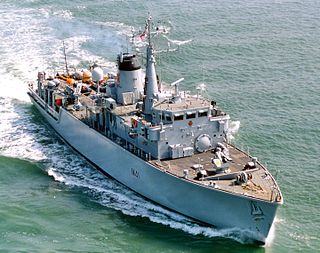
HMS Quorn, the third ship of this name, was a Hunt-class mine countermeasures vessel of the Royal Navy. She was launched on 23 January 1988, as the last ship of her class.

The Hunt class is a class of thirteen mine countermeasure vessels of the Royal Navy. As built, they combined the separate roles of the traditional minesweeper and that of the active minehunter in one hull, but later modifications saw the removal of mine-sweeping equipment. They have a secondary role as offshore patrol vessels.

The Sandown class is a class of fifteen minehunters built primarily for the Royal Navy by Vosper Thornycroft. The Sandown class also serve with the Royal Saudi Navy and the Estonian Navy. The first vessel was commissioned into Royal Navy service on 9 June 1989 and all the British ships are named after coastal towns and cities. They have a secondary role as offshore patrol vessels.

The Commander-in-Chief Fleet (CINCFLEET) was the admiral responsible for the operations of the ships, submarines and aircraft of the British Royal Navy from 1971 until April 2012. The post was subordinate to the First Sea Lord, the professional head of the Naval Service. In its last years, as the Navy shrank, more administrative responsibilities were added.

HMS Tyne is a River-class offshore patrol vessel built by Vosper Thornycroft in Southampton for the Royal Navy to serve as a fishery protection unit within the United Kingdom's waters along with her two sister ships Mersey and Severn. All three were commissioned into service in 2003 to replace the five older Island-class patrol vessels.

The Ton class were coastal minesweepers built in the 1950s for the Royal Navy, but also used by other navies such as the South African Navy and the Royal Australian Navy. They were intended to meet the threat of seabed mines laid in shallow coastal waters, rivers, ports and harbours, a task for which the existing ocean-going minesweepers of the Algerine-class were not suited.
The Northern Ireland Squadron was a unit of the British Royal Navy. It was established during the conflict in Northern Ireland known as the Troubles to interdict the movement by sea of illegal arms for paramilitaries and to provide other material support for anti-terrorist operations in Northern Ireland. It existed from 1969 to 1998.
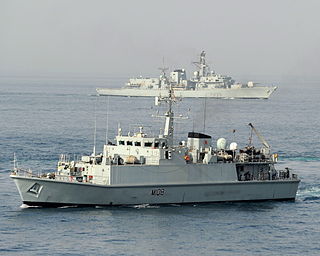
HMSGrimsby is a Sandown-class minehunter of the British Royal Navy, and the second ship to bear the name.
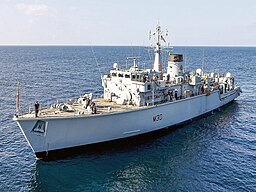
HMS Ledbury, the second ship of the name, is a Hunt-class mine countermeasures vessel of the Royal Navy. She was launched in December 1979 and commissioned on 11 June 1981, the second ship of her class. She cost £65 million at time of building, which was at the time the most expensive cost-per-metre for any class of ship built by the Royal Navy. Most of this cost went into the research and development of Ledbury's glass reinforced plastic hull.

HMSInverness(M102) was a Sandown-class minehunter of the Royal Navy. She was decommissioned by the Royal Navy in 2005, and in 2008 became EMLSakala(M314) of the Estonian Navy.

HMS Brocklesby is a Hunt-class mine countermeasures vessel of the British Royal Navy, her primary purpose is to find and neutralise sea mines using a combination of; Sonar, Mine Clearance Divers and the Seafox remotely operated vehicle (ROV). The class are the largest warships of glass-reinforced plastic (GRP) construction, which gives the vessels a low magnetic signature. In addition to her mine countermeasures activities, Brocklesby acts as an offshore patrol vessel, undertaking coastal patrol and fisheries protection duties.
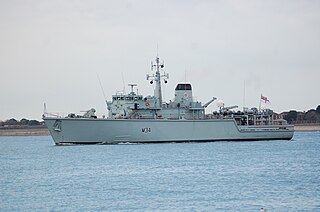
HMS Middleton is a Hunt-class mine countermeasures vessel of the British Royal Navy. As of 2021, she forms part of Nine Mine Countermeasures Squadron operating out of HMS Jufair in Bahrain.
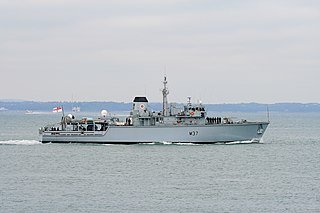
HMS Chiddingfold is a Hunt-class mine countermeasures vessel of the British Royal Navy. She was launched in October 1983 by her sponsor, Lady Anne Kennon, and formally entered the service of the Royal Navy in October 1984. Chiddingfold is a minehunter, and her purpose is to find and destroy mines, not only in a time of war but also in peacetime. There are about a quarter of a million mines still active from the Second World War alone and they pose a major threat to both military and civilian ships. Chiddingfold is able to enter some types of minefields without the mines detonating. This is because she is made of glass-reinforced plastic and all fixtures within the ship are made of non-ferrous metals, keeping the ship's magnetic signature to the bare minimum.

HMS Atherstone was a Hunt-class mine countermeasures vessel of the Royal Navy, the third ship to bear the name. She was built by Vosper Thornycroft shipbuilders at Woolston, Southampton. She was launched on 1 March 1986 by Mrs Amy Jarvis, the wife of Mr Pat Jarvis, CB, the Deputy Controller of the Navy at the Ministry of Defence, and commissioned on 17 January 1987. She was the tenth ship of her class.
HMS Berkeley was a Hunt-class mine countermeasures vessel of the British Royal Navy. She was sold to the Hellenic Navy in 2001 and was commissioned as HS Kallisto. On 27 October 2020, she was cut in two in a collision with a container ship.

EML Admiral Cowan (M313) is a Sandown-class minehunter. Formerly HMS Sandown, lead ship of her class of the Royal Navy, she is now an Estonian Navy ship. Renamed EML Admiral Cowan, she is the flagship of the Estonian Navy and part of the Estonian Navy's mine sweeping flotilla. Admiral Cowan is the lead vessel of the Estonian Navy Mineships Division and also the first of the three modernised Sandown class minehunters received.

BNS Anushandhan is a survey vessel of the Bangladesh Navy. She previously served with the Royal Navy as the coastal survey vessel HMS Roebuck (H130) from 3 October 1986 to 15 April 2010. She was the last traditional survey ship to serve in the Royal Navy. In 2010, she was sold to the Bangladesh Navy. She was handed over to the Bangladesh Navy on 28 May 2010. On 1 June 2010 she sailed for Bangladesh. She is the first dedicated hydrographic survey ship to serve with Bangladesh Navy.
In 1989 the Royal Navy was under the direction of the Navy Department in the UK Ministry of Defence. It had two main commands, CINCFLEET and Naval Home Command.
Junella was a fishing trawler, best known for her service with the Royal Navy during the Falklands War. She was built in 1975 for J Marr & Son, a Hull-based fishing company. On 11 April 1982 she was taken up from trade by the British government and commissioned into the Royal Navy. She was fitted with Second World War era minesweeping gear at Rosyth Dockyard, manned by Royal Navy sailors and allocated to the 11th Mine Countermeasures Squadron. She sailed on 26 April but was unable to commence sweeping until after the 14 June Argentine surrender. In the meantime she was utilised to transfer troops and stores between ships and landed special forces troops at San Carlos. Demining operations commenced on 21 June. Junella returned to the United Kingdom on 11 August, carrying a defused Argentine mine.














